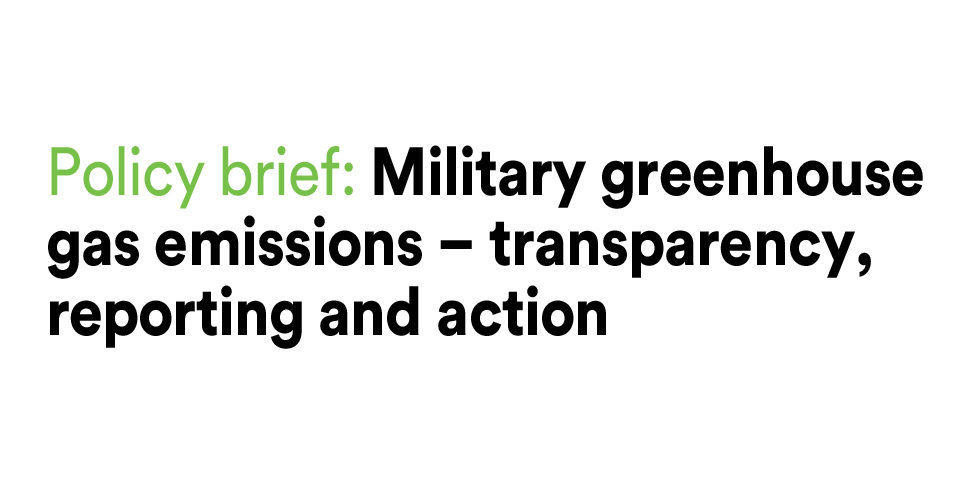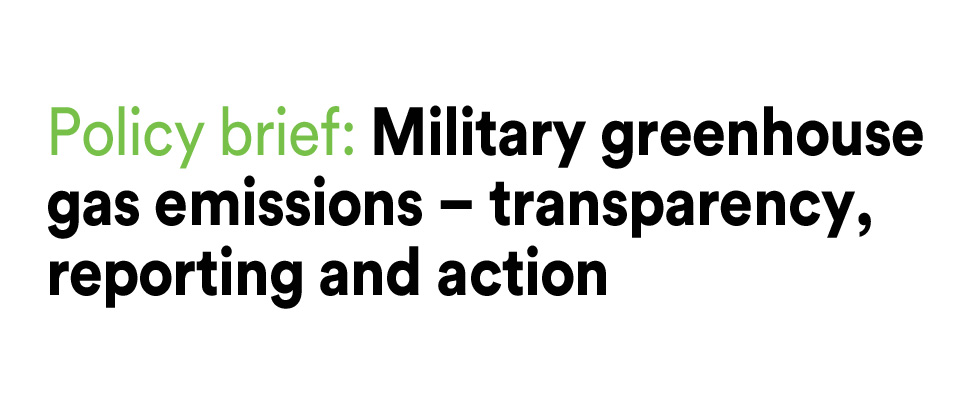Summary
Militaries are huge fossil fuel consumers and have large and complex supply chains, yet only a few have published climate mitigation strategies and set specific greenhouse gas (GHG) reduction targets.
Militaries must be included in reduction strategies if governments are to meet their own national targets. This will first require a framework for credible and transparent military GHG emissions reporting. Transparency is key for understanding how military activities and procurement contribute to the climate crisis, and where action must be focused to reduce emissions. It is also vital for public confidence in military emissions reduction targets.
Key messages
- Action is required by all sectors in response to the climate crisis, including the military.
- It is unreasonable to expect other sectors – including food production and healthcare – to reduce their emissions and not expect militaries to do the same.
- Robust and transparent GHG reporting is needed to support effective decision-making and military carbon management.
- GHG emissions from warfighting itself – such as from fires, damaged infrastructure and reconstruction needs – are currently ignored, and should also be included in military carbon accounting.
- Military and conflict emissions should be addressed within the framework of the UNFCCC.
Why is military GHG emission reporting important?
Militaries have begun to recognise their outsized role in contributing to the climate crisis, although they remain heavily reliant on fossil fuels and will be locked into fossil fuel intensive vehicles and equipment for decades to come.
GHG emissions cannot be effectively managed without measuring them. However, whilst the UN Framework Convention on Climate Change (UNFCCC) obliges some states to report on their GHG emissions every year, reporting military emissions is voluntary and not consistent across countries. Without even a minimum reporting obligation to the UNFCCC, most countries – including those with large military expenditures and numbers of personnel – do not require their militaries to provide any meaningful GHG emissions reporting.
The cost of inaction
Global military expenditure for 2021 is estimated at around US$ 2.1 trillion, and is rising. Each dollar spent has a carbon cost and for countries with large militaries, military emissions may contribute more than 50% of central government emissions. While the size and activity levels of militaries varies between countries, all militaries need to urgently improve their GHG reporting. Scrutiny can help drive GHG emission reductions, but in the absence of robust and transparent GHG reporting for the military, governments:
- Are incapable of making informed decisions around climate and military policy.]
- Have no clear understanding of the overall scale of their military’s contribution to the climate crisis.
- Have no clear understanding of how military emission reduction strategies may perform.
Excluding the military from national GHG reporting and emission reduction targets is unreasonable when all other sectors – including food production and healthcare – are expected to cut emissions.
Policy recommendations – what should governments ask of their militaries?
States must ensure that:
- Their military is reporting GHG emissions under a credible and transparent framework.
- Military GHG reporting and carbon management is used to drive whole life GHG reductions, and across all military activities and the military supply chain.
- Military reporting must include GHG emissions from military activities and warfighting itself, which are currently grossly overlooked. This would include emissions from fires, damage to infrastructure and reconstruction needs.
States should also support the inclusion of military GHG emissions on the UNFCCC’s agenda, and drive improvement of UNFCCC reporting obligations.
To learn more about the emissions sources associated with military activities and armed conflicts, see our proposed framework for military GHG emissions reporting.






